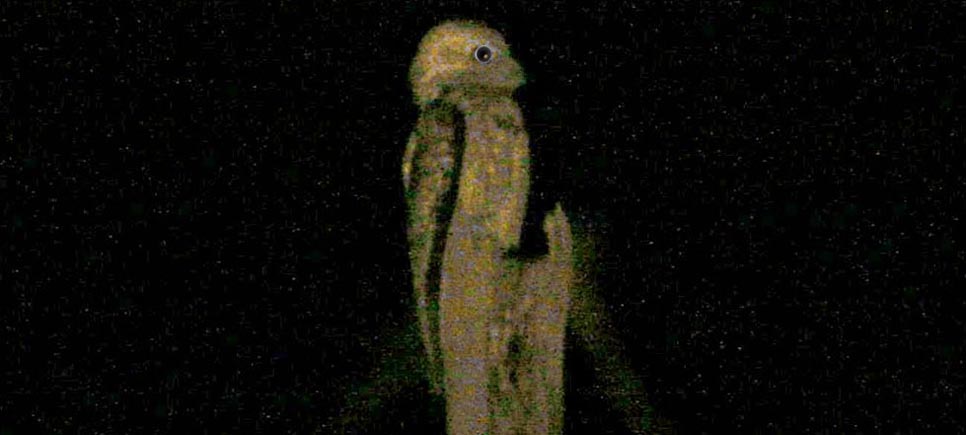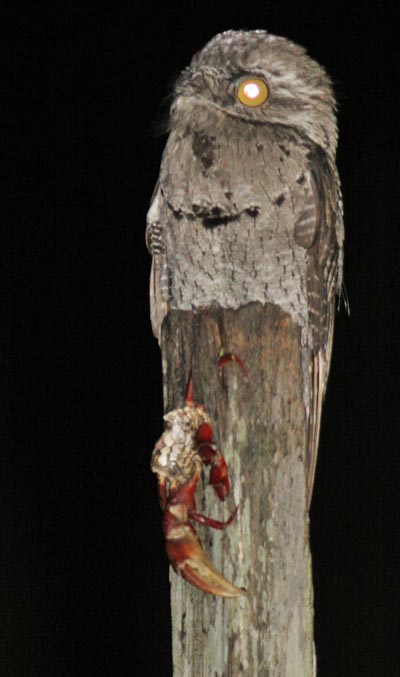
a web page by Don Roberson |
POTOOS Nyctibiidae |
|
Personally, my three potoos are the easier species — and seen at night — such as this Common Potoo (below) in the Brazilian Pantanal.
|
Ridgely & Gwynne (1989) nicely summarize the characteristics of potoos: "The resemble the nightjars in many respects, especially in their large eyes, cavernous mouths, and nocturnal habits, but differ in their greater size and more or less upright (not horizontal) posture. They are rarely seen by day, for they then rest motion less, often high in a tree, looking like an extension of a dead snag or stump. The the bird is unaware of one's presence, it head is hunched into its body and its bill is in a natural, forward position." This Common Potoo (right, in another nice Toni Kimple photo, this one from Panama) seems in normal posture with its feet wrapped around the tip of the perch. Ridgely & Gwynne (1989) continue: "Usually, however, the potoo will see the observer before you see it, and it then slowly assumes the typical stretched-out position with the bill pointing skyward. More easily seen at night (especially when the moon is full) when the birds may be calling and amy be seen perching on prominent lookout. They feed on insects caught on the wing, usually returning to their original perch after a sally. The nest in nonexistent: a single egg is laid in the small depression or crevice created by a broken-off branch." Cohn-Haft (1999) adds "Because they are nocturnal, cryptic in plumage and behaviour, and live in the canopy of dense and remote forest, potoos are among the least studied of birds." It is known that they eat a wide variety of flying insects; beetles are favored but during hatches of flying termites, those are consumed in large quantities. Long-tailed Potoo, one of the largest species, was seen chasing flying termites in the understory, twisting and turning in pursuit, but never even brushing its wings or tail against the vegetation. Potoos engulf the prey whole. The mouth is lined with skin tough enough to endure the sharp spines, claws, and mandibles of large beetles. A White-collared Seedeater — presumable flushed from a night perch — was once found in a potoo's stomach (ibid.). |
 |
Beyond their unworldly physiognomy — if any bird 'looks' like a Martian, surely it is the ghostly Great Potoo at night (above) — the potoos favor us with some of the weirdest and some of the most beautiful vocalizations in the avian world. The standard night-call of the Great Potoo is as strange as its appearance, a loud, far-carrying, explosive "brarrrr" (Ridgely & Gwynne 1989), sometimes rendered as "a harsh sickly-sounding 'KWAAAHA' " (Cohn-Haft 1999), or as our physician-guide in Panama, Jaime Pujols, described it: "the dying retch of the terminal patient." Having experienced it in the dark at various tropical locations, I can state that it is always unsettling. In contrast, the song of Common Potoo is a "deep, melancholy, wonderfully modulated series of four to eight wailing notes, falling in pitch, loudest at first and falling off at the end; perhaps most aptly paraphrased as "poor-me-all-alone" (Ridgely & Gwynne 1989). In fact, the local vernacular name of this bird in Trinidad is "Poor-me-one," an onomatopoeic interpretation of its song. Both males and females sing the song, although the male's version is louder and more aggressive. Cohn-Haft (1999) says: "This is the most plaintively beautiful of all potoo songs. The experience of hearing a Common Potoo in a rainforest bathed in moonlight is one that marks it listener for life. The combination of eerie melancholy and mystery surrounding potoos make hearing their song on the the quintessential Neotropical experiences." Cohn-Haft (1999) mentions the local people sometimes misidentify the voices of potoos as other animals. For example, the song of Common Potoo is attributed to a sloth in some places, but elsewhere is said to be a pygmy anteater. In the Brazilian Amazon, the song of White-winged Potoo N. leucopterus is often thought to be given by the "curupria, a mythical forest spirit that protects animals from hunters." If only this were true . . . . |
Photos: Toni Kimple used an iPhone to digiscope the adult and baby Long-tailed Potoo Nyctibius aethereus at Pantiacolla Lodge, Madre de Dios, Peru, in Nov 2015. My nightime photo of Common Potoo N. griseus
was along the Rio Claro, Brazilian Pantanal, on 23 July 2010; Tony
Kimple's shot of Common Pottoo is from a day roost is from the
Metropolitan NP, Panama City, Panama, in August 2012. The night photo
of Great Potoo N. grandis was in the Brazilian Pantanal in July 2010. Bibliographic note: There is no "family book" on this new family, but a very good introduction to the family, with excellent photos, is in Cohn-Haft (1999). Literature cited:
|
 The nocturnal Potoos are entirely restricted to the Neotropics, with seven species in one genus (Nyctibius). Three species are widespread but four are local and highly desired by birders. One of those is Long-tailed Potoo
(left), and in this engaging photo by Toni Kimple, we see an adult
sheltering a downy youngster at its nesting location. The baby blends
imperceptibly into the tree trunk. Long-tailed Potoo has a wide Amazon
Basin range where it "is very poorly known" but is likely "overlooked
rather than really rare." (Cohn-Haft 1999). Small populations in
Atlantic and Choco forests are threatened.
The nocturnal Potoos are entirely restricted to the Neotropics, with seven species in one genus (Nyctibius). Three species are widespread but four are local and highly desired by birders. One of those is Long-tailed Potoo
(left), and in this engaging photo by Toni Kimple, we see an adult
sheltering a downy youngster at its nesting location. The baby blends
imperceptibly into the tree trunk. Long-tailed Potoo has a wide Amazon
Basin range where it "is very poorly known" but is likely "overlooked
rather than really rare." (Cohn-Haft 1999). Small populations in
Atlantic and Choco forests are threatened. 
 Although
Potoos today are entirely restricted to the Neotropics, they were once
more widespread as there is a fossil from Europe (Cohn-Haft 1999). In
many ways they resemble the Frogmouths [Podargidae] of the Old World
tropics in southeast Asia and Australasia, but they are only distantly
related. The closest relative to Potoos is also Neotropical — the
Oilbird [Steatornithidae] — and Potoos separated from that group about
55 million years ago (Prum et al. 2015).
Although
Potoos today are entirely restricted to the Neotropics, they were once
more widespread as there is a fossil from Europe (Cohn-Haft 1999). In
many ways they resemble the Frogmouths [Podargidae] of the Old World
tropics in southeast Asia and Australasia, but they are only distantly
related. The closest relative to Potoos is also Neotropical — the
Oilbird [Steatornithidae] — and Potoos separated from that group about
55 million years ago (Prum et al. 2015).